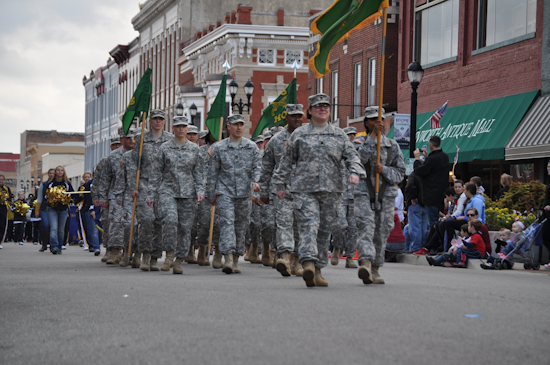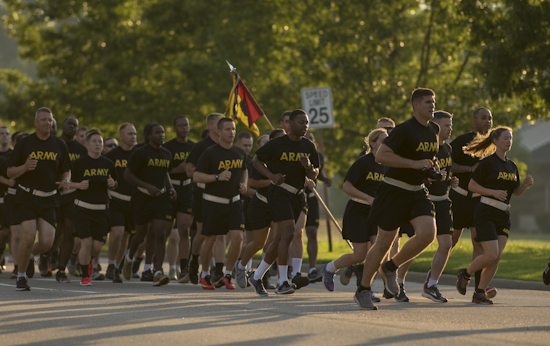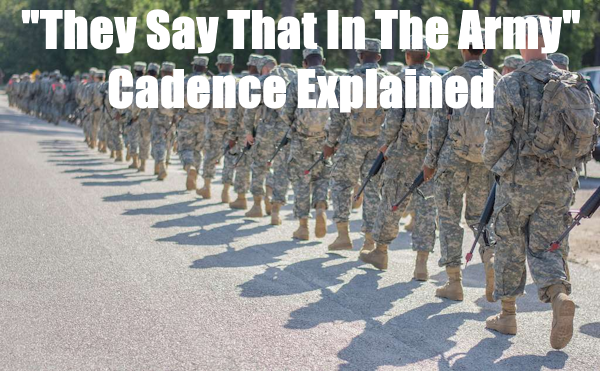“They Say That in the Army” is a popular military cadence. It’s used by drill instructors and those leading a march to maintain formation.
While a military cadence is referred to as an inflection of the voice, it can also be a marching rhythm or beat.
Learn more about the meaning and purpose of the “They Say That in the Army” cadence.
Related Article – E4 Mafia Explained: 5 Things You (Probably) Didn’t Know
Table of Contents
“They Say That in the Army” Cadence Explained

What is the meaning of the “They Say That in the Army” cadence? The military anthem is part of a series of cadences (more information, below) used in the service branch.
A cadence is defined as “an inflection of the voice” designed to highlight or accent certain words in a series of repeated sentences.
Therefore, military cadences often are used as a rhythm or beat to keep a formation in order.
Military cadences are frequently used while marching or running because they maintain a steady beat and help soldiers keep step in time.
Moreover, military cadences like “They Say That in the Army” serve as an important distraction during grueling exercises.
As a result, the military cadence is one of the most popular and well-known in the United States Army.
The “They Say That in the Army” cadence has been around since at least the American Revolutionary War.
It’s been incorporated as an anthem for other service branches yet remains the most prominent in the Army.
The cadence usually features the same lyrics aside from a few variations depending on the service branch and instructor.
“They Say That in the Army” Lyrics
The “They Say That in the Army” military cadence is usually repeated as follows:
They say that in the Army, the chow is mighty fine.
A chicken jumped off the table and started marking time.
(Refrain) Oh, Lord I wanna go HOO-HOO-HOOOOMMEE, Hey!
They say in the Army, the pay is mighty fine
They give you a hundred dollars and take back ninety-nine.
(Refrain) Oh, Lord I wanna go HOO-HOO-HOOOOMMEE, Hey!
The purpose of the refrain is for the formation to end with the final word in the previous line (i.e. “home”).
Then, at each refrain, the final word is stretched out over 8 paces before concluding with “hey” or “eh” on the right foot.
Generally, the military cadence continues with something like:
They say that in the Army, the coffee’s mighty fine
It looks like muddy water, and tastes like turpentine.
(Refrain)
They say that in the Army, the biscuits are mighty fine
One rolled off the table and killed a friend of mine.
(Refrain)
They say that in the Army, the pancakes are mighty fine
You can try to chew them, but you’re only wasting time.
(Refrain)
Soldiers might hear other humorous chants related to “They Say That in the Army,” such as:
They say that in the Army, the hours are just right
Start early in the morning and work on through the night.
(Refrain)
They say that in the Army,
the tents are waterproof
You wake up in the morning and you’re floating on the roof.
(Refrain)
These are just a few examples of the types of marching cadences you might hear during your time in the military.
Related Article – GT Score Explained (And How To Raise It)
What is a Marching Cadence?

A cadence is defined as a “balanced, rhythmic flow” common with poetry and speeches.
Often, there is a precise measure or beat within the cadence that makes them suitable for marching or running.
For this reason, the U.S. Armed Forces have adopted many types of military cadences, or jodies.
These military chants are often overheard at Army basic training and during physical training (PT) exercises.
The rising or falling inflection of the voice is designed to keep the soldiers on pace and in the correct formation.
Furthermore, military cadences serve as a distraction for troops and help maintain morale during intense physical exercise.
Military cadences like “They Say That in the Army” are often self-deprecating and designed to keep the mood light.
Often, they take a humorous or satirical approach to military service, calling out some of the flaws or frequent complaints of service.
Nonetheless, military cadences have a far larger purpose than simply following “left-right-left.”
In fact, cadences like “They Say That in the Army” have a “call and response” structure to keep soldiers focused and ready.
Purpose of Jody Calls (“Jodies”)
Jody calls instill teamwork and camaraderie while also challenging a soldier to move to the beat at normal speed (quick time) or march / running-in-formation (double time).
Singing cadences allow soldiers to run or march while keeping their heads up, taking deeper breaths, and exhaling more forcefully.
All of these factors have been demonstrated to improve oxygen supply to the lungs, fueling the body with more energy and motivation.
In addition to the “They Say That in the Army” cadence, you’ll also hear these jody calls on an Army installation:
- The Duckworth Chant (“Sound Off!”)
- “Old King Cole”
- “Blood Upon the Risers”
- “I Wish All the Ladies”
- “Captain Jack”
- “Yellow Ribbon”
Jody calls often revolve around common themes like homesickness, deprivations, and other everyday complaints about military life.
Furthermore, they are also beloved for their comedic value along with the ability to boast about individual unit accomplishments.
Related Article – 43 Military Hand Signals Explained
Conclusion
“Yellow Ribbon” is one of the more popular military cadences.
The chant generally pokes fun at some of the less desirable parts of military service, including the food and work demands.
Nevertheless, “Yellow Ribbon” — like other cadences — is largely designed to boost troop morale and camaraderie.
For this reason, military cadences are a harmless albeit important segment of daily military life.
Featured Image Source – Nara.GetArchive.net
- Replacing Dog Tags: 6 Things You Need to Know - June 28, 2024
- Navy OAR Test Study Guide - June 24, 2024
- 10 Best Sniper Movies of all Time - June 20, 2024
Originally posted on July 23, 2023 @ 4:24 pm
Affiliate Disclosure: This post may contain affiliate links. If you click and purchase, I may receive a small commission at no extra cost to you. I only recommend products I have personally vetted. Learn more.

